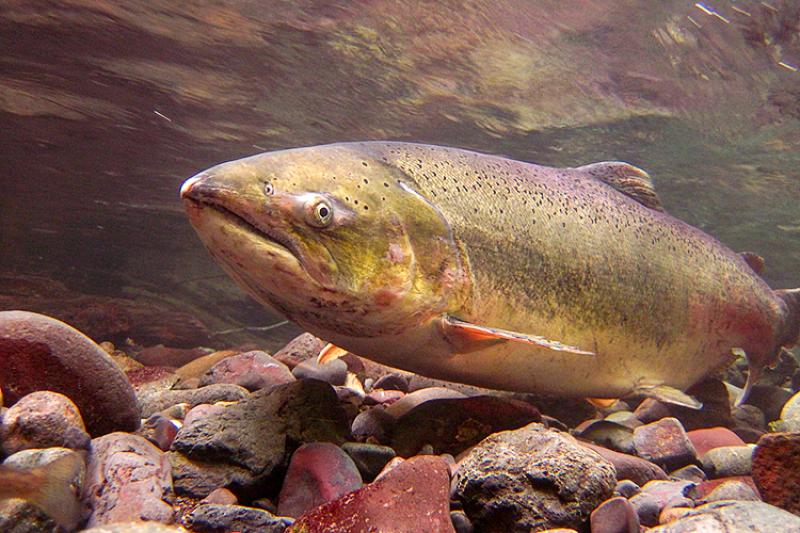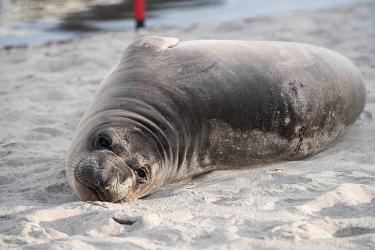An influx of $27 million from the Office of Habitat Conservation under the Bipartisan Infrastructure Law and Inflation Reduction Act is reinvigorating efforts to restore threatened salmon and trout species in Oregon’s Willamette River watershed.
“This funding is a true lifeline to restoration practitioners who have been working to recover Endangered Species Act-listed Upper Willamette River Chinook and steelhead,” says NOAA Fisheries Biologist Anne Mullan. “These species are on the downward trajectory, but this funding gives us hope.”
Multiple major dams on the Willamette River tributaries stand between salmon and steelhead and their historic spawning grounds in the upper watershed. The Office of Habitat Conservation’s Restoration Center and its partners are restoring degraded habitat in the lower watershed. NOAA Fisheries’ West Coast Region works with the U.S. Army Corps of Engineers and others to provide passage for Chinook salmon and steelhead between the lower river and their upstream spawning habitat.
Four awards to the McKenzie Watershed Alliance, American Rivers, the Confederated Tribes of Grand Ronde, and the Clackamas Partnership will:
- Restore floodplain and side channel habitat to provide spawning and rearing habitat for salmon and steelhead
- Remove multiple barriers to fish passage including a dam on a Willamette River tributary
- Reduce the risks of flooding, forest fires, and drinking water contamination
- Provide jobs, educational and workforce development opportunities, new accessible greenspace, and recreational activities to local community members
In addition to helping Upper Willamette River Chinook and steelhead, the work will benefit other listed salmon and trout species as well as Pacific lamprey, which are important to Native American tribes.
“What’s exciting about this large influx of funding is that our partners are able to implement multiple large- and small-scale projects all at one time,” says Lauren Senkyr, Marine Habitat Resource Specialist for NOAA. “In the past it might have taken 5 to 10 years to get all of this work done. We’re pushing the fast-forward button on restoration and recovery.”
NOAA staff also help partners review project designs and monitoring plans and speed up permitting and regulatory compliance processes so they can start construction sooner.
Historically, hundreds of thousands of Chinook salmon and steelhead returned to the Willamette River Basin in Oregon to spawn. Fish counts at the Willamette Falls fish ladders show those numbers have plummeted. The current 5-year average annual return is about 30,000 Chinook and 3,000 steelhead. Aside from the major dams, pollution, climate change, and habitat degradation caused by development are threatening the survival of migratory fish.
“Salmon and steelhead move between streams, rivers, estuaries, and the ocean, depending on their life stage,” says NOAA Marine Habitat Resource Specialist Larissa Lee. “In each habitat they need places to hide and forage and certain temperature or chemical cues to tell them to move on to the next stage. It’s difficult to control the ocean, but we can improve conditions on land by giving them access to high-quality habitat for spawning adults and rearing juveniles.”
Why Restore Threatened Species?
Willamette salmon and trout stocks once supported robust fisheries that benefited commercial fishers, the tourism industry, and local communities. Salmon and trout also hold cultural significance with local tribes. “These species have been important to the culture and diet of the people of the Pacific Northwest for thousands of years,” says Megan Hilgart, Marine Habitat Resource Specialist for NOAA. “There's a really strong commitment to try to get back the subsistence-level fisheries for the tribes.”
In addition, salmon bring nutrients from the ocean deep inland, supporting entire forest ecosystems. Pacific salmon species die after spawning. Their bodies provide food for species ranging from black bears to Douglas fir, which absorb nutrients from decaying fish through their roots.
The restoration work itself provides jobs and educational opportunities, helps mitigate flood and forest fire risks, and will invite the community back to rivers and waterfront parks.
NOAA’s Office of Habitat Conservation is reinvigorating efforts to help restore the health of rivers and forests in the Willamette Valley for both wildlife and people. Learn more about the four related restoration projects being funded under the Bipartisan Infrastructure Law and Inflation Reduction Act in this area:
- 10 Projects Will Support Urban Fish Restoration around Portland, Oregon
- NOAA Partners to Remove Kellogg Dam, Providing Passage for Threatened Chinook, Coho, and Steelhead
- McKenzie River Restoration Benefiting Threatened Upper Willamette River Chinook
- Reestablishing Connections for Fish and Tribes on Oregon’s North Santiam River





